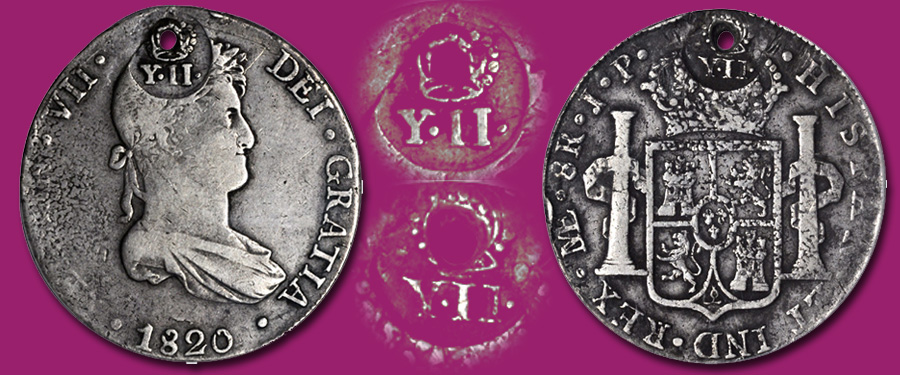
This week’s preview from our August 2017 Official
Auction at the ANA World’s Fair of Money in Denver, Colorado is a somewhat obscure
item from the Philippines. Lot 21357 features a Peru Bust 8 Reales with crowned
Y.II. countermarks over both sides of the hole . Usually holes in coins are considered damage,
as for the most part the holes result from piercing after the coins left the
mint. In some instances in the cut and
countermarked series plugs were officially removed by a government entity for
assaying and/or inflation (lower intrinsic value with nominal face value). There are instances where plugs were
unofficially removed by unscrupulous individuals trying to make a little extra
on the side. In these instances the
holes were made for a very specific reason.
However, with the perforated (holed) coins of the Philippines, the holes
were authorized after the fact by the decree of 4 September 1834. This decree
states that the holed or pierced coins would be accepted as legal tender as
long as countermarks were applied over both sides of the hole. With that said,
not every perforated example has countermarks over both sides of the hole. The
pieces with only one countermark have it on the obverse, in accordance with the
original decree of 2 October 1832, where all countermarks were to be applied to
the obverses of the hosts.
On
27 August 1834, a decree was issued stating that pierced coins were no long
acceptable legal tender. This did not
sit well with the local populace and nearly caused an uprising. Due to the disgruntled locals, the government
at Manila issued the 4 September 1834 decree where holed coins with
countermarks over both sides would again become legal tender.
It
is worth noting that when the countermarks were applied to both sides they were
done at the exact same time. If they were applied in succession one of the sides
would show flattening. Additionally the punches, though usually rotated to one
degree or another are in alignment with each other. This suggests that one or both punches were
affixed somehow either as a hammer and anvil die or by using a device like a
pair of pliers, similar to the Guatemala Type IV countermarks issued in late
1840 to early 1841.
It
is noted in the August lot description that the pair of punches used to countermark
the present example match an example from the Ray Czahor collection (also with
a previous “F.7.0” countermark) from our NYINC 2015 auction lot 1425. Further
comparison to examples in our records finds several pieces share the same pair
of punches as well as a few which share only one of the punches while the other
differs. The most significant specimen from this comparison is in the American
Numismatic Society (ANS) collection http://numismatics.org/collection/1927.999.238?lang=en acquired in 1927, which
was pierced twice with countermarks over both side of both holes. Another
significant example was found in Jose T. Madina’s early work “Las Monedas
Obsidionales Hispano-Americanas,” published in Santiago de Chile 1919. For a
more recent picture (although not as clear as the one plated in Madina) refer
to Ponterio & Associates auction # 14 April 25, 1984, lot 329. Both of these
examples share the same pairing of punches as the present example.
The
perforated examples from the Philippines are quite scarce and very
interesting. Including all of the
various perforated types (countermarks over both sides, over only obverse and
additional countermarks) we have in our records approximately 70 examples cited.
By far the most common are the examples with countermarks over both sides with
40 examples. The next most common is the examples with an additional
countermark with 21 examples. All others should be considered extremely rare. Our
records indicate that for this particular countermark/host coin combination we
have three of this bust type from the Lima mint, with the present example being
a fourth unrecorded example. All have different dates.
We
are no longer accepting consignments for our August ANA auction. We are however
taking consignments of world and ancient coins and world paper money for our
October Collectors Choice Online (CCO) auction, our January 2018 New York
International Numismatic Convention (NYINC) and our April 2018 Hong Kong
Showcase Auctions. If you are interested in consigning your coins and paper
currency (whether a whole collection or a single rarity) be sure to contact one
of our consignment directors.





